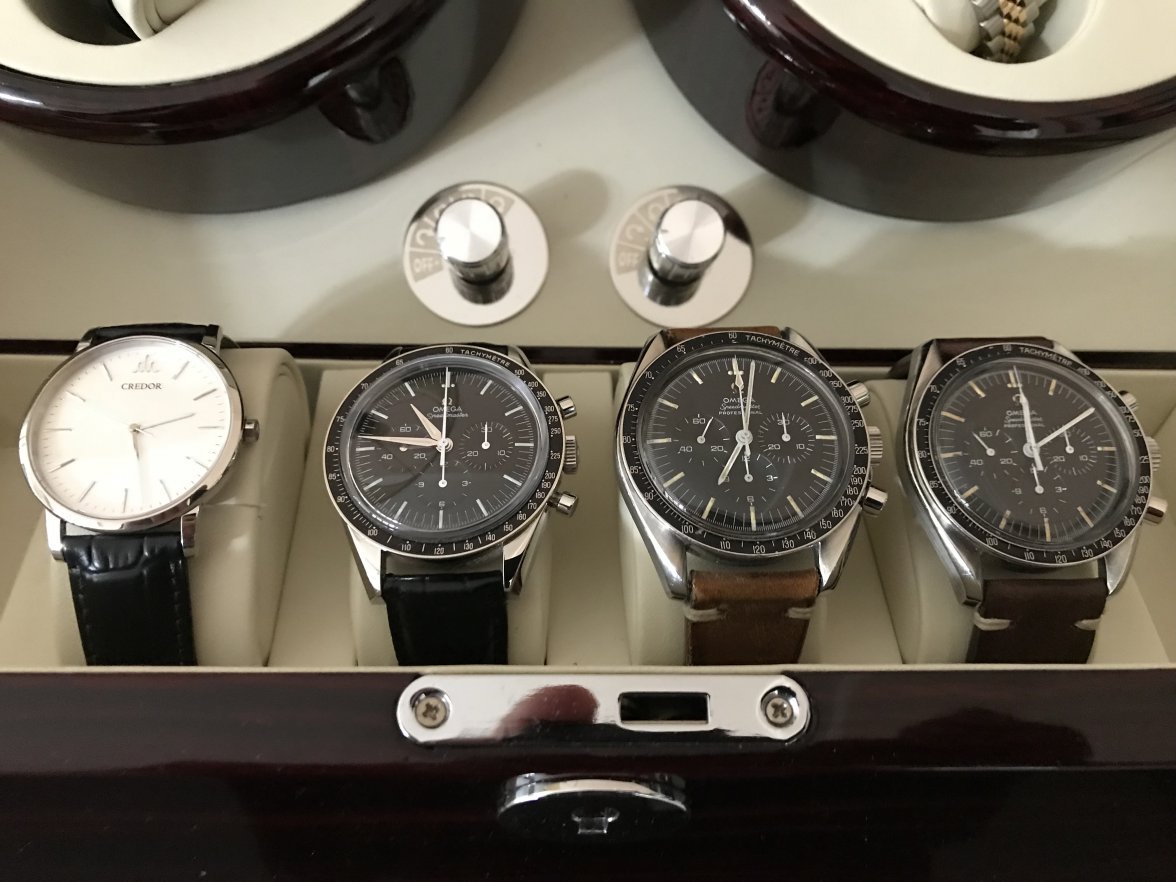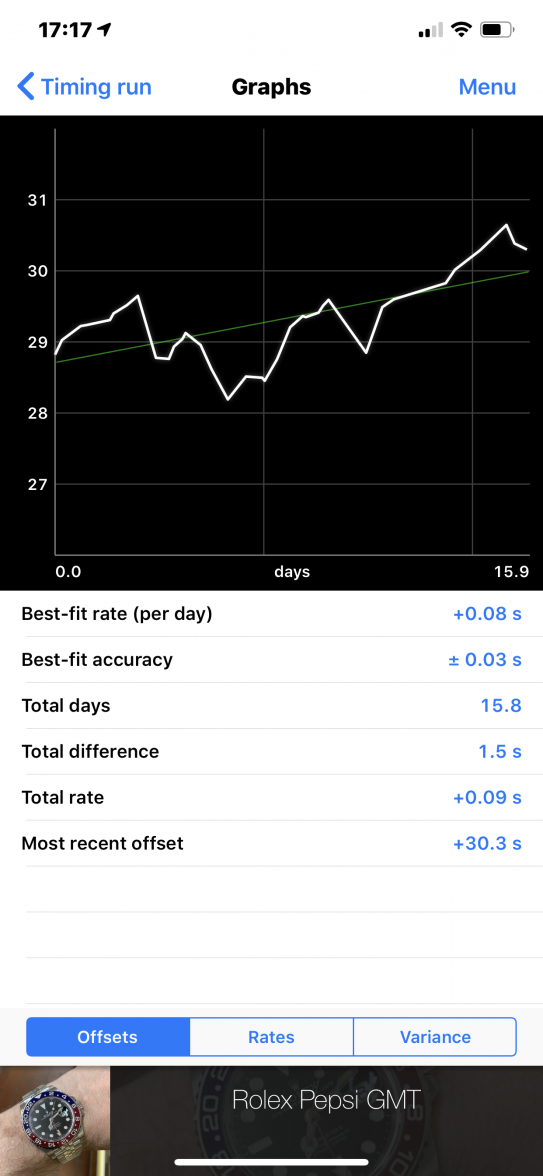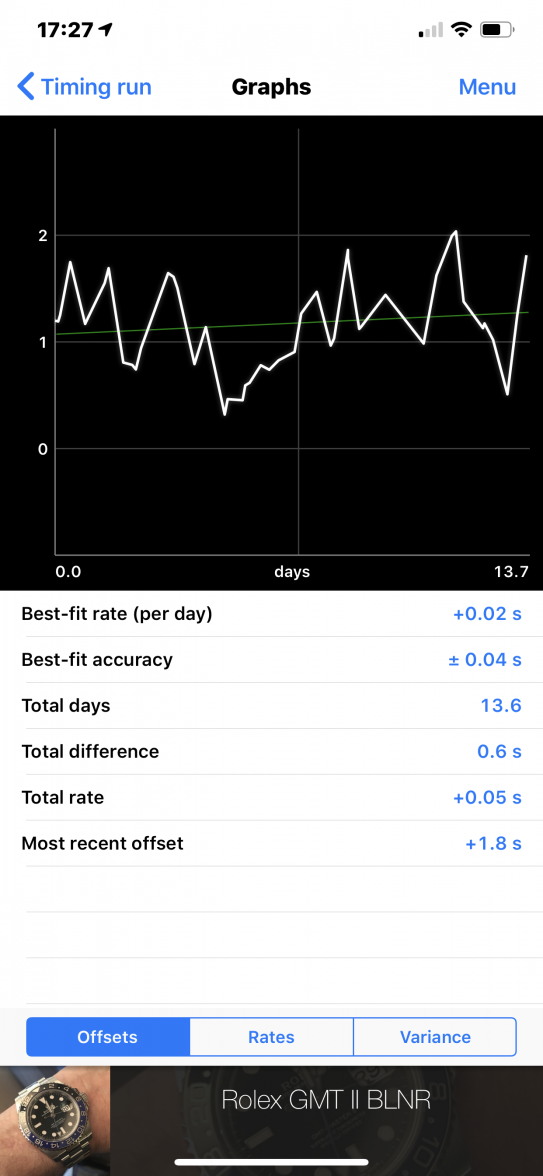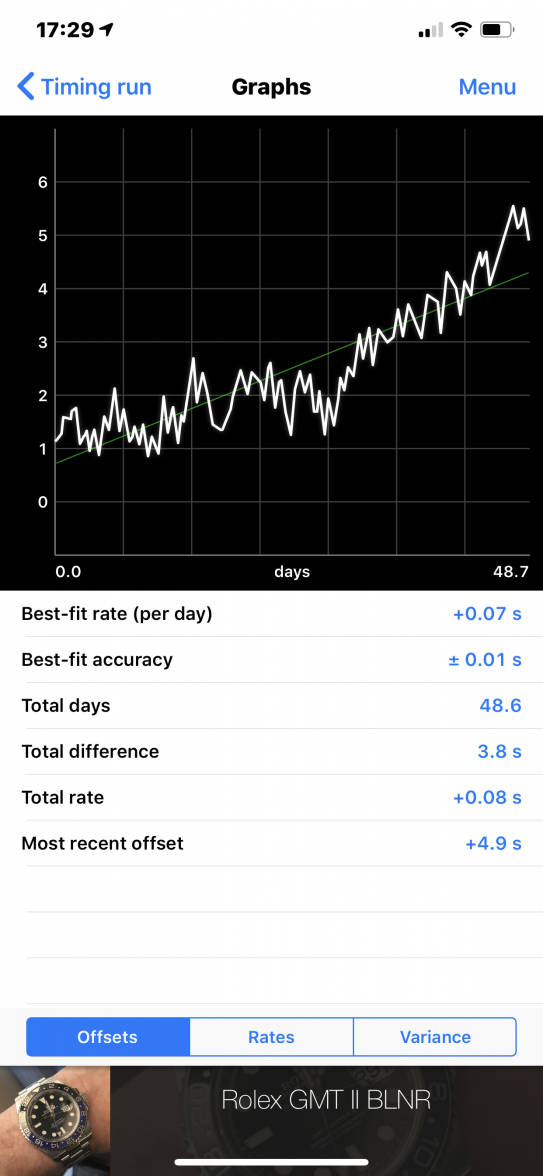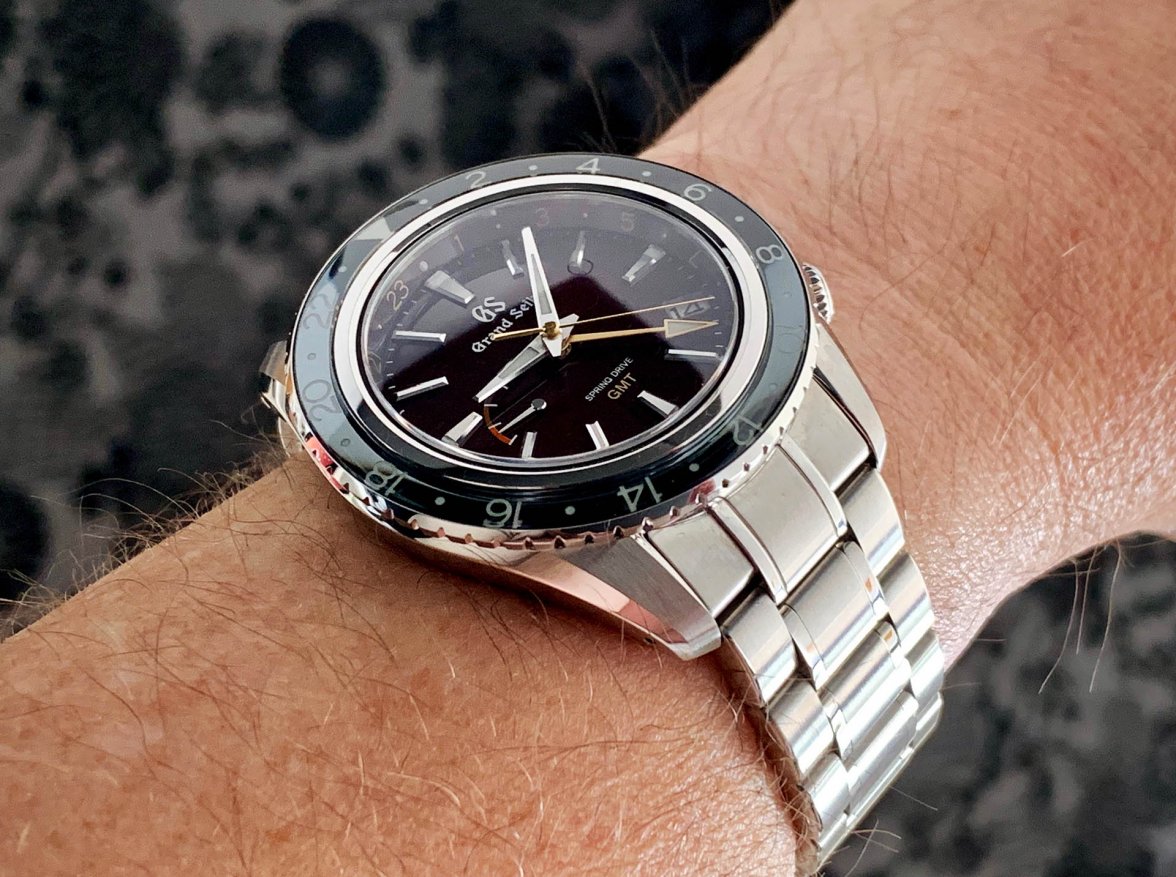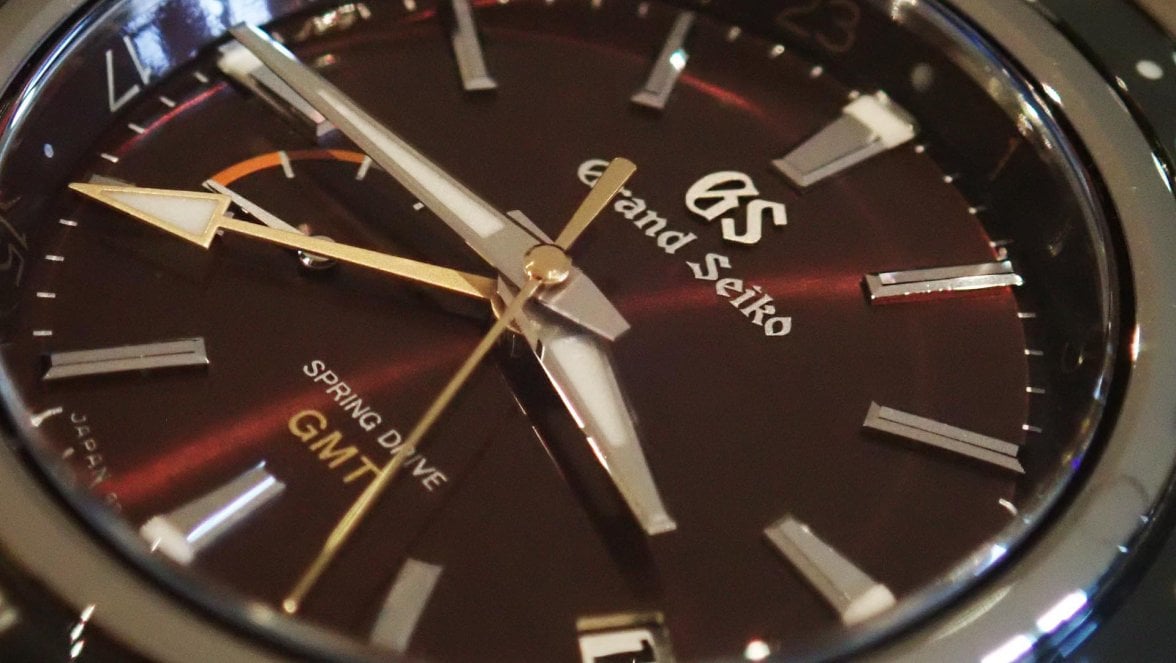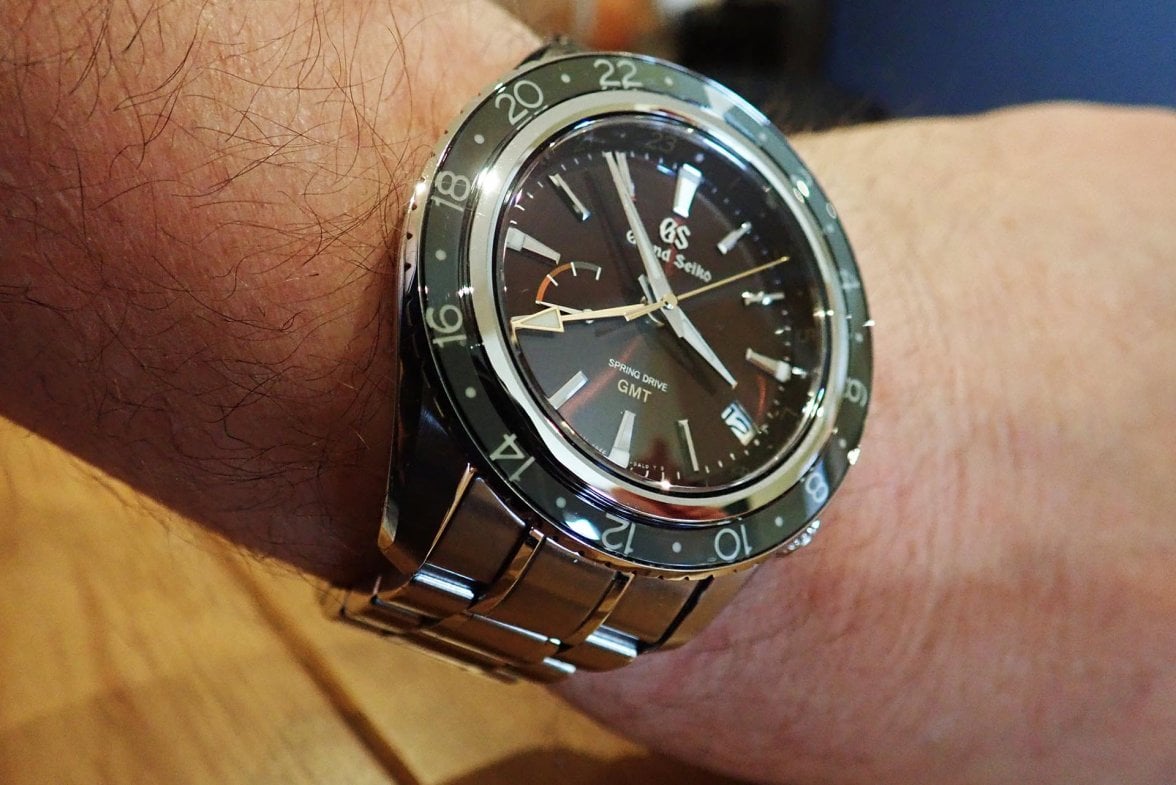Is Grand Seiko getting better?
Khamenman
·Bless the internet for always managing to bring out long and pointless arguments. I feel like 99.9% of the time, these debates just come down to people arguing on technicalities and subjective definitions. Kind reminds me of jordan peterson debates on 'feminism'.
Regardless, a photo of a friend's GS reissue. beautiful watch, may be on the list for daily-dress-beater one day!

Archer
··Omega Qualified WatchmakerI had read a while back that Seiko were trying to set-up repair facilities for spring drives in other countries, but not sure if that has happened yet...so yes likely going back to Japan every 3 years if you follow their recommendations.
Evitzee
·I'm new to Grand Seiko this year so can't say anything about them getting better. But I will say their dials blow almost amy Swiss or German watch away in finishing quality and clarity. I've had most Swiss brands at the high levels (Patek Philippe, AP, VC, Lange, Breguet, Journe, etc) and Rolex, Omega and others, and have often lamented about the often flat, listless appearance of the dials and relatively poorly finished indices and markings. Take a look at any Grand Seiko under a loupe and you'll find diamond polished indices and hands along with crisp, clear markings on the dial. Way above the industry standard, imo.
The industry has tried to improve timekeeping for centuries through all kinds of methods, some of them gimmicks. Tourbillons, all kinds of escapements (cylinder, detent, lever, coaxial and Spring Drive), remontoires, multiple spring barrels, improved oils, better hairsprings, better materials, etc, etc. Most of the research done by the Swiss over the last century or so. The Japanese invented the Spring Drive concept and perfected it which probably rankles people in the Swiss based industry. I look at a Spring Drive as a mechanical watch with a quartz regulator that does not require a battery to operate. If you want to call it a quartz watch, fine, but it isn't like the billions of battery operated quartz movements that have been around for 40 years and which most collectors ignore. Collectors, for the most part, don't want a watch that requires a battery to operate. A Spring Drive is a mechanical watch powered by your wrist that happens to have a quartz regulation. Call it what you will.
Much has been made that a battery quartz watch will outperform a Spring Drive. OK, but the real question is how many Swiss or German mechanical watches will outperform a Spring Drive in accuracy over a long period of time? The answer is, not many. I've only had mine for six months and if it isn't on my wrist it's on an Orbita winder at 650 rotations per day (auto reversing) and it has consistently run at +0.7 seconds per WEEK. Maybe it's just a freak occurrence, but please give me an out of the box mechanical watch that will keep that kind of accuracy.
Grand Seiko recommends a full service every three or four years, but this is NOT due to anything about the electronic escapement. Per their operating manual: "For the Spring Drive, wear and damage occur less than mechanical watches since the spinning speed of the rotor is adjusted by a 'contact free' electromagnetic brake. However, as the structure of the gear train is the same as mechanical watches, abrasion powder may be generated by contact of the wheels and pinions." So a Spring Drive watch should probably run longer than a lever escapement, all things considered. Most watches will easily go five or six years these days and I would expect a Spring Drive model to at least go this long, or longer, assuming it is constructed to similar standards as most Swiss watches.
Grand Seiko is just starting to expand in the US now (since 2017) so there will be some growing pains along the way in the service area but I don't think this is a reason not to buy one. And isn't current Grand Seiko management in the US now headed by an old Omega hand? Whether that is good or bad remains to be seen, but they seem to be going in the right direction.
The industry has tried to improve timekeeping for centuries through all kinds of methods, some of them gimmicks. Tourbillons, all kinds of escapements (cylinder, detent, lever, coaxial and Spring Drive), remontoires, multiple spring barrels, improved oils, better hairsprings, better materials, etc, etc. Most of the research done by the Swiss over the last century or so. The Japanese invented the Spring Drive concept and perfected it which probably rankles people in the Swiss based industry. I look at a Spring Drive as a mechanical watch with a quartz regulator that does not require a battery to operate. If you want to call it a quartz watch, fine, but it isn't like the billions of battery operated quartz movements that have been around for 40 years and which most collectors ignore. Collectors, for the most part, don't want a watch that requires a battery to operate. A Spring Drive is a mechanical watch powered by your wrist that happens to have a quartz regulation. Call it what you will.
Much has been made that a battery quartz watch will outperform a Spring Drive. OK, but the real question is how many Swiss or German mechanical watches will outperform a Spring Drive in accuracy over a long period of time? The answer is, not many. I've only had mine for six months and if it isn't on my wrist it's on an Orbita winder at 650 rotations per day (auto reversing) and it has consistently run at +0.7 seconds per WEEK. Maybe it's just a freak occurrence, but please give me an out of the box mechanical watch that will keep that kind of accuracy.
Grand Seiko recommends a full service every three or four years, but this is NOT due to anything about the electronic escapement. Per their operating manual: "For the Spring Drive, wear and damage occur less than mechanical watches since the spinning speed of the rotor is adjusted by a 'contact free' electromagnetic brake. However, as the structure of the gear train is the same as mechanical watches, abrasion powder may be generated by contact of the wheels and pinions." So a Spring Drive watch should probably run longer than a lever escapement, all things considered. Most watches will easily go five or six years these days and I would expect a Spring Drive model to at least go this long, or longer, assuming it is constructed to similar standards as most Swiss watches.
Grand Seiko is just starting to expand in the US now (since 2017) so there will be some growing pains along the way in the service area but I don't think this is a reason not to buy one. And isn't current Grand Seiko management in the US now headed by an old Omega hand? Whether that is good or bad remains to be seen, but they seem to be going in the right direction.
A J
·I had read a while back that Seiko were trying to set-up repair facilities for spring drives in other countries, but not sure if that has happened yet...so yes likely going back to Japan every 3 years if you follow their recommendations.
Archer
··Omega Qualified WatchmakerI'm new to Grand Seiko this year so can't say anything about them getting better. But I will say their dials blow almost amy Swiss or German watch away in finishing quality and clarity. I've had most Swiss brands at the high levels (Patek Philippe, AP, VC, Lange, Breguet, Journe, etc) and Rolex, Omega and others, and have often lamented about the often flat, listless appearance of the dials and relatively poorly finished indices and markings. Take a look at any Grand Seiko under a loupe and you'll find diamond polished indices and hands along with crisp, clear markings on the dial. Way above the industry standard, imo.
The industry has tried to improve timekeeping for centuries through all kinds of methods, some of them gimmicks. Tourbillons, all kinds of escapements (cylinder, detent, lever, coaxial and Spring Drive), remontoires, multiple spring barrels, improved oils, better hairsprings, better materials, etc, etc. Most of it done by the Swiss over the last century or so. The Japanese invented the Spring Drive concept and perfected it which probably rankles some people. I look at a Spring Drive as a mechanical watch with a quartz regulator that does not require a battery to operate. If you want to call it a quartz watch, fine, but it isn't like the billions of battery operated quartz movements that have been around for 40 years and which most collectors ignore. It's a mechanical watch powered by your wrist that happens to have a quartz regulation. Call it what you will.
Much has been made that a battery quartz watch will outperform a Spring Drive. OK, but the real question is how many Swiss or German mechanical watches will outperform a Spring Drive in accuracy over a long period of time? The answer is, not many. I've only had mine for six months and if it isn't on my wrist it's on an Orbita winder at 650 rotations per day (auto reversing) and it has consistently run at +0.7 seconds per WEEK. Maybe it's just a freak occurrence. Please give me an out of the box mechanical watch that will keep that kind of accuracy.
Grand Seiko recommends a full service every three or four years, but this is NOT due to anything about the electronic escapement. Per their operating manual: "For the Spring Drive, wear and damage occur less than mechanical watches since the spinning speed of the rotor is adjusted by a 'contact free' electromagnetic brake. However, as the structure of the gear train is the same as mechanical watches, abrasion powder may be generated by contact of the wheels and pinions." So a Spring Drive watch should probably run longer than a lever escapement, all things considered. Most watches will easily go five or six years these days and I would expect a Spring Drive model to at least go this long, or longer, assuming it is constructed to similar standards as most Swiss watches.
Grand Seiko is just starting to expand in the US now (since 2017) so there will be some growing pains along the way in the service area but I don't think this is a reason not to buy one. And isn't current Grand Seiko management in the US now headed by an old Omega hand? Whether that is good or bad remains to be seen, but they seem to be going in the right direction.
Externally, the finishing is most certainly excellent. On the movement, decoration it is at or below Rolex/Omega level, and certainly not comparable to anything truly high end.
If you want to say it "just happens" to have a quartz oscillator, that's fine, but it is the sole source of timekeeping in this watch, so it is a quartz watch. It is certainly different than other quartz watches out there in some ways, and again this go back to my statement about it being the worst of both worlds. Okay so as not to upset Wiz and those who think like him, I won't say worst, I'll simply say that as a quartz watch, the timekeeping is nothing special as I've illustrated. On the service, indeed it has nothing to do with the quartz factor, and I don't believe anyone said it did. This is the drawback of this watch that it has loads on the pivots all the time it's wound just like a mechanical watch does, so unlike a "normal" quartz watch that uses a rotor that pulses every second, and has load on the pivots at most for about 8 milliseconds out of every second, this has loads in it constantly.
A "regular" analog quartz watch can go for decades without any wear or need for service, so as long as the consumption doesn't exceed the specs, I don't bother servicing them. If they need service it's often much cheaper to simply replace the movement, so for the most part the only quartz watches I really ever service are vintage movements that don't have a suitable replacement movement.
So the spring drive is a quartz watch that requires frequent full servicing compared to a regular quartz watch because of the mechanical components, and doesn't necessarily exceed the accuracy of all other quartz watches. When I think of what the big advantage is with this watch, it comes down to one thing - the smooth sweep of the seconds hand. For me personally, that's not worth spending the sort of money these cost for a quartz watch that's going to need to be sent to Japan every 3 or 4 years for an expensive overhaul...
And yes timekeeping has advanced a lot over the centuries, with the culmination of all the being the High Accuracy Quartz. The spring drive doesn't advance that at all, and in the end the reason I collect mechanical watches is certainly not because of accuracy, since any quartz watch from Walmart bought for $10 can do that, so not exactly huge bragging rights I think.
But everyone has their own choice, and if you really love the watch by all means have at it. For me the aesthetics are not my thing, and before I buy any watch I have to like how it looks, and whatever else makes it "specal" is secondary. Buy what you like.
Cheers, Al
dscoogs
·I am not a watchmaker, so have no idea on the finishing of the movement other than what I read on OF.
I bought my Credor - not a GS, but close enough - for day to day work watch b/c I liked the design & excellent external finishing and the accuracy of +/- 10 secs/yr. Between 2 DST changes and several trips across time zones per year, the Credor time error usually hovers around 1-2 seconds at any point in time. I am also currently considering the GS SBGW231 as a manual wind dress watch, again mainly due to the design & excellent external finishing.
BTW, I also like Speedmasters ... 😀
I bought my Credor - not a GS, but close enough - for day to day work watch b/c I liked the design & excellent external finishing and the accuracy of +/- 10 secs/yr. Between 2 DST changes and several trips across time zones per year, the Credor time error usually hovers around 1-2 seconds at any point in time. I am also currently considering the GS SBGW231 as a manual wind dress watch, again mainly due to the design & excellent external finishing.
BTW, I also like Speedmasters ... 😀
larryganz
·...I've only had mine for six months and if it isn't on my wrist it's on an Orbita winder at 650 rotations per day (auto reversing) and it has consistently run at +0.7 seconds per WEEK. Maybe it's just a freak occurrence, but please give me an out of the box mechanical watch that will keep that kind of accuracy...
I got a Rolex SS Pepsi GMT II in April of this year. I checked the accuracy from May 31st to June 16th, over approximately 16 days. I set the watch randomly to another watch, which was about 28.8 seconds behind atomic time because all I cared about was the gain or loss vs atomic time, not staying right on top of Atomic.
Between May 31st and June 7th (1 week) it lost 0.3 seconds, but was at +/- 0 seconds on June 8th (8 days). By June 16th it had gained 1.5 seconds since May 31st.
It averaged + 0.66 seconds per week during that time. So, not as consistent, but it ran anywhere from -0.3 sec/week to +1.5 sec/week. As you can see from the chart, for most of the first two weeks the GMT was within +/- 1 second of the original time that I'd set it.
There were 7 points at which the watch read the exact same relative time as when I'd set it at 28.8 seconds ahead of atomic time the first day; so if I'd randomly checked it just once at 10-11 days out, then I would have been able to say the watch hadn't gained or lost time in that many days.
THIS WAS NOT A FLUKE, BECAUSE WHEN I GOT MY GMT II BLNR IT ALSO ONLY AVERAGED ABOUT +0.3 SECONDS PER WEEK OVER 2 WEEKS.
OVER A 7 WEEK PERIOD WITH SIMILAR RESULTS AT LESS THAN 0.55 SEC/WEEK
Edited:
- Posts
- 13
- Likes
- 12
Wiz
·Well, last Friday I had the day off and went to Bluewater. I went to the Omega boutique and tried on the black and white Planet Ocean GMT, which I’ve admired for a long time. I thought it was going to be the one, however despite being a fan of watches that have some heft, the thickness of it (I think it’s 17mm) just gave me pause for second thought. So I went to Chisholm Hunter and looked at the GSs. I’ve read online that it’s very hard to photograph Grand Seiko and that even their stock photos don’t do them justice, but I was really quite taken aback by the difference. Even in video, it’s seems impossible to capture the way light plays on the dial as it does when seen with the naked eye. Now I see what all the fuss is about the dial on a snowflake - if only I’d had the budget for two watches I would have walked out with one of those as well as a GMT!
After much deliberation, I decided to put my money where my mouth has been and bought the limited edition SBGE245, as has already seen on this thread. I just loved the way the light catches it, the ghosting effect on the bezel and way the dial changes between mahogany a deep green/black colour depending upon how you look at it.
Last Friday I set synchronised the time with my Apple watch. Today, exactly 7 days later, I just videoed it to see how it compared. I guess I must be yet another person who just “happened” to get a good one! 😀
After much deliberation, I decided to put my money where my mouth has been and bought the limited edition SBGE245, as has already seen on this thread. I just loved the way the light catches it, the ghosting effect on the bezel and way the dial changes between mahogany a deep green/black colour depending upon how you look at it.
Last Friday I set synchronised the time with my Apple watch. Today, exactly 7 days later, I just videoed it to see how it compared. I guess I must be yet another person who just “happened” to get a good one! 😀
- Posts
- 13
- Likes
- 12
Wiz
·The industry has tried to improve timekeeping for centuries through all kinds of methods, some of them gimmicks. Tourbillons, all kinds of escapements (cylinder, detent, lever, coaxial and Spring Drive), remontoires, multiple spring barrels, improved oils, better hairsprings, better materials, etc, etc. Most of the research done by the Swiss over the last century or so. The Japanese invented the Spring Drive concept and perfected it which probably rankles people in the Swiss based industry. I look at a Spring Drive as a mechanical watch with a quartz regulator that does not require a battery to operate. If you want to call it a quartz watch, fine, but it isn't like the billions of battery operated quartz movements that have been around for 40 years and which most collectors ignore. Collectors, for the most part, don't want a watch that requires a battery to operate. A Spring Drive is a mechanical watch powered by your wrist that happens to have a quartz regulation. Call it what you will.
I think you're exactly right, to call is a "quartz" watch is shows a good deal of naivety about how it works. The defining factor is that ALL other analogue quartz watches, without exception, move the watch hands with an electric motor, however Spring Drive, moves the hands by means of a main spring, just like all other fully mechanical watches (the clue is in the name 😝). Whether that's the best or worst of both worlds depends upon what you like or dislike about mechanical/quartz watches:
Looked at objectively, it's the best of both worlds because there are two main complaints people who don't like quartz movements usually have: 1). With most quartz, you have to change the battery, which could fail at a very inconvenient moment, especially in a dive watch where its function can be life-critical and the temperature shock of cold water can kill a battery suddenly. 2) Mechanical watch fans usually hate the slow tick of most quartz watches, which is necessary for battery longevity. Yes, there are a few quartz watches which move several times a second, but that is at the expense of battery life and efficiency. Spring Drive solves both these points inarguably and elegantly. No battery change, a flawlessly sweeping second hand yet retains quartz accuracy. However for some people, the challenge of designing a purely mechanical solution to the problem of regulation is a big part of the appeal of a watch and Spring Drive isn't a purely mechanical solution, so it loses its appeal. If that factor bothers you, it's not for you, but I tend to make decisions logically rather than emotionally and so for me it's definitely the best of both worlds - hence my choice 😁
Edited:
Archer
··Omega Qualified WatchmakerI think you're exactly right, to call is a "quartz" watch is shows a good deal of naivety about how it works. The defining factor is that ALL other analogue quartz watches, without exception, move the watch hands with an electric motor, however Spring Drive, moves the hands by means of a main spring, just like all other fully mechanical watches (the clue is in the name 😝). Whether that's the best or worst of both worlds depends upon what you like or dislike about mechanical/quartz watches:
Looked at objectively, it's the best of both worlds because there are two main complaints people who don't like quartz movements usually have: 1). With most quartz, you have to change the battery, which could fail at a very inconvenient moment, especially in a dive watch where its function can be life-critical and the temperature shock of cold water can kill a battery suddenly. 2) Mechanical watch fans usually hate the slow tick of most quartz watches, which is necessary for battery longevity. Yes, there are a few quartz watches which move several times a second, but that is at the expense of battery life and efficiency. Spring Drive solves both these points inarguably and elegantly. No battery change, a flawlessly sweeping second hand yet retains quartz accuracy. However for some people, the challenge of designing a purely mechanical solution to the problem of regulation is a big part of the appeal of a watch and Spring Drive isn't a purely mechanical solution, so it loses its appeal. If that factor bothers you, it's not for you, but I tend to make decisions logically rather than emotionally and so for me it's definitely the best of both worlds - hence my choice 😁
Congrats on your new watch! I hope you enjoy it.
For the record, I know exactly how it works, and it's regulated solely by a quartz crystal, and therefore is a quartz watch that is driven by a spring. Spring dirve...the clue is in the name...😀
- Posts
- 13
- Likes
- 12
Wiz
·Congrats on your new watch! I hope you enjoy it.
For the record, I know exactly how it works, and it's regulated solely by a quartz crystal, and therefore is a quartz watch that is driven by a spring. Spring dirve...the clue is in the name...😀
Thanks 😀. I suppose given what I said earlier and you seem to have repeated above, all mechanical watches are "spring drive" 😁🍿
That apart, the watch isn't quite perfect. I really wish more manufacturers would adopt tritium tubes rather than a lume that charges up and then doesn't really work after a few hours. When I find myself looking at a watch in the dark, the only analogue one that I can always see is a Luminox 1945, which I still like (despite being quartz 😜). Also, I really wish they'd put a display back on it. I agree with you that the movement isn't in the same league as a AP or VC, but it's still good enough to look at - certainly they think so on the Snowflake. Do you think that the backs would be interchangeable? I also think that the stainless ring on the inside of the bezel could be much thinner, it's verging on to much bling when seen in the flesh. Sound like a lot to complain about but I'm nit-picking, I love the watch and if I really need to know the exact time in the dark, I'll look at my phone 🤪. I'll be genuinely curious to check the time on this in another 3 weeks to see where it's at after a month. After a week it actually looks spot on, which is better than I would have thought possible for a non-TH. I think there probably is a healthy degree of luck involved and I think that Seiko do under spec them as they don't want any returns for watches being outside of spec, but if I'm just lucky I'll take that happily.
Archer
··Omega Qualified WatchmakerYes, and some quartz watches made by Seiko are as well. 😀
Well, I wear an Omega SM300 Watchco model to bed every night, and after a few seconds under a light it's bright all night long. There are a lot of factors that affect how long modern lume lasts...grain size, thickness of the coating, area of course, if the plots are back-painted...not sure why the lume on this dies so quickly, but I can assure you there are watches with great lume out there that don't require tritium. Tritium half life is about 25 years, so 12.5 years in it's going to glow about 1/2 as much. The tubes are popular with some brands, but I also get requests from people to swap out "dead" tritium tube hands. Each system has positives and negatives.
No idea.
Overall I like the model you have purchased, more so than the dress models. One thing I've never liked is the font GS uses. Both the gothic style font that is their logo, and the fact that as a brand they seem to want to set records for having the most different fonts on one single dial. This one's not too bad for that...
- Posts
- 13
- Likes
- 12
Wiz
·This is an interesting thread: https://forums.watchuseek.com/f74/10-hours-lume-comparison-omega-fortis-seiko-steinhart-957849.html
Kinda backs up what you said about the quantity of lume used. Usually in total darkness it's fairly easy to see the lume, where I find it harder is in dark but not totally dark settings, when the glint from the polished edges on the hands is actually easier to see than the lume, but that might be an age thing as much as anything else. I don't think this model lends itself to larger hands with more lume, seems like a good excuse to look for another watch 🤔. I really like the vintage Omegas, in fact I even like the modern reboots and looked at them when I was in the boutique, you're very lucky to have a Watchco one.
Kinda backs up what you said about the quantity of lume used. Usually in total darkness it's fairly easy to see the lume, where I find it harder is in dark but not totally dark settings, when the glint from the polished edges on the hands is actually easier to see than the lume, but that might be an age thing as much as anything else. I don't think this model lends itself to larger hands with more lume, seems like a good excuse to look for another watch 🤔. I really like the vintage Omegas, in fact I even like the modern reboots and looked at them when I was in the boutique, you're very lucky to have a Watchco one.
WiZARD
·This is an interesting thread: https://forums.watchuseek.com/f74/10-hours-lume-comparison-omega-fortis-seiko-steinhart-957849.html
ahh, that was a long time ago, and I think this comparison was flawed as I continuously changed the exposition settings...
this is better, with the same settings for all pics 😉 https://prohardver.hu/tema/svajci_es_egyeb_orak_topicja/hsz_146977-146977.html
larryganz
·Cool results. Impressive timekeeping.
I'm curious to know how you measure the watch accuracy with sub-second resolution.
You need something like WatchTracker App on my iPhone, and a consistent reaction time. I have to tap on my iPhone screen in the app when my watch is reading the exact same time as the time that I pre-selected in the app.
For instance, if my watch says that the time is 12:29 PM and 45 seconds, then I'll set the time in the app for 12:30PM. I then wait until my watch says that it's exactly 12:30 PM - and at that exact moment I quickly tap on the phone screen.
The app will then compare the actual time to when I tapped the screen, and see if I hit the screen at exactly right moment, too early, or too late (to see if the watch is falling behind atomic time or moving ahead of atomic time).
I will usually check the result a second time right away, to see if I reaction time is consistently within 1/10th of a second, and if so then I consider the result to be valid and I delete one of the extra results. The longer you go between checking the time keeping the less important a 1/10th of a second error in reaction time will be. So, I usually won't check the time keeping more often than 2-4x a day, at least 6-12 hours apart.
For example - a 1/10th second error in each of two measurements 3 hours apart could lead to as much as a 1.6 sec/day error in the results (or they could cancel each other out). But if you wait 6 hours between checking the results, then the maximum daily rate error would only be as much as half that, at 0.8 sec/day (again, assuming you are off by 1/10th second each time you take a measurement).
It took some training to get my reaction times down to within one or two 10ths of a second of the actual moment the second had meets the desired marker.
- Posts
- 2,326
- Likes
- 7,545
pongster
·Not that am buying one soon. But the expert discussion here makes me wanna rethink my pursuit of an eichi ii.
And should i be happy with just one spring drive in my collection (together with another kinetic and an AGS). Still dont have a HAQ though. And heard good things about the 9F movements.
And should i be happy with just one spring drive in my collection (together with another kinetic and an AGS). Still dont have a HAQ though. And heard good things about the 9F movements.
larryganz
·Not that am buying one soon. But the expert discussion here makes me wanna rethink my pursuit of an eichi ii.
And should i be happy with just one spring drive in my collection (together with another kinetic and an AGS). Still dont have a HAQ though. And heard good things about the 9F movements.
The 9F is a great movement. My GS SBGX115 9F based diver runs just under + 6 sec/year. And the external finishing and dial/hand finishing is outstanding and on par with my Swiss watches. Plus the movement service intervals are 50 years, other than a battery change and pressure testing every few years.
I often wish that I had also bought the SBGX117 in black tile as well, before it was discontinued. But the new SBGX337 Japanese market watch with blue dial is very appealing to me.
My 3rd Generation Omega X-33 runs + 5 sec/year, and looks like more of a tool watch while the GS looks like a luxury diver. But it’s also a HAQ watch worth owning. I would not give those 2 up, even though there are cheaper watches out there that stay as (or more) accurate via connection to the atomic clock radio, or GPS satellites, or to the Internet through your smart phone. The problem is the cheaper WATCHES will not have the fit or finishing that you get with the Omega or Grand Seiko.
However, beauty of adding a Seiko Astron or Casio Protrek to the collection are that they run for decades on solar power, and all you have to do is make sure that they update for daylight savings time or when changing location, depending on the watch’s features.
I’ve also had my eye on a grand Seiko 9F based GMT at the local authorized dealer, but with over two dozen quartz watches at home I’m frequently having to replace batteries, so that dead ones don’t leak inside the watch when I don’t wear them for a long period of time. I don’t know if this is likely to be a problem in a cheaper watch Vs a Grand Seiko, but I’ve heard that some watches are more likely to have battery leakage than others based on the way that they drain the battery. I don’t know if this is true.
larryganz
·PS: The way that I look at it, I can have a quartz watch that needs a battery every 2 to 4 years for $10-$165 each time, a solar powered quartz watch that needs a new capacitor every 10 to 30 years for $60-$200, or a spring drive quartz that never needs a battery but does need an expensive service every 4 to 5 years instead.
I’m not 100% sure the smooth sweeping second hand is worth the extra expense versus a full mechanical watch, where you could marvel at how such tiny delicate machinery tracks time so well.
I’m not 100% sure the smooth sweeping second hand is worth the extra expense versus a full mechanical watch, where you could marvel at how such tiny delicate machinery tracks time so well.

